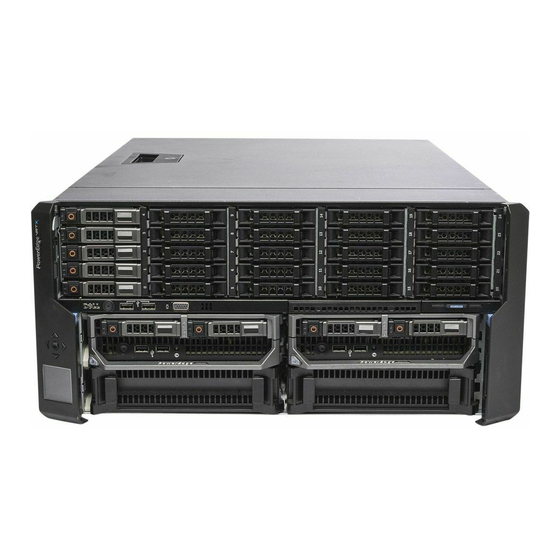Dell poweredge VRTX Manual del usuario - Página 10
Navegue en línea o descargue pdf Manual del usuario para Interruptor Dell poweredge VRTX. Dell poweredge VRTX 35 páginas. Server
También para Dell poweredge VRTX: Manual de introducción (30 páginas), Nota de publicación (5 páginas), Manual de introducción (14 páginas), Manual de inicio rápido y referencia (2 páginas), Manual técnico (45 páginas), Primeros pasos (2 páginas)

NOTE: You cannot disable BGI permanently. If you cancel BGI, it automatically restarts within five minutes.
NOTE: Unlike full or fast initialization of virtual disks, background initialization does not clear data from the physical
disks.
NOTE: CC or BGI typically causes some loss in performance until the operation completes.
Full Initialization Of Virtual Disks
CAUTION: Performing a full initialization on a virtual disk overwrites all blocks and destroys any data that
previously existed on the virtual disk. Full initialization of a virtual disk eliminates the need for the virtual disk to
undergo a BGI. Full initialization can be performed after the creation of a virtual disk.
During full initialization, the host is not able to access the virtual disk. You can start a full initialization on a virtual disk in
the CMC.
NOTE: For detailed navigation of the CMC for Shared PERC 8, see the
PowerEdge VRTX User's Guide at dell.com/esmmanuals.
NOTE: If the system reboots during a full initialization, the operation terminates and a BGI begins on the virtual disk.
Fast Initialization Of Virtual Disks
A fast initialization on a virtual disk overwrites the first and last 8 MB of the virtual disk, clearing any boot records or
partition information. The operation takes only 2-3 seconds to complete and is recommended when you are recreating
virtual disks. You can perform a fast initialization in the CMC.
NOTE: A BGI starts five minutes after the Fast Initialization is completed.
NOTE: For detailed navigation of the CMC for Shared PERC 8, see the
PowerEdge VRTX User's Guide at dell.com/esmmanuals.
Disk Roaming
Disk roaming is moving the physical disks from one backplane slot to another on the same controller. The controller
automatically recognizes the relocated physical disks and logically places them in the virtual disks that are part of the
disk group. You can perform disk roaming only when the system is turned off.
Using Disk Roaming
Perform the following steps to use disk roaming:
1.
Turn off the power to the system, physical disks, enclosures, and system components.
2.
Disconnect power cables from the system.
3.
Move the physical disks to desired positions on the backplane or the enclosure.
4.
Perform a safety check. Make sure the physical disks are inserted properly.
5.
Turn on the system.
The controller detects the RAID configuration from the configuration data on the physical disks.
10
Dell Chassis Management Controller for Dell
Dell Chassis Management Controller for Dell
